2020 MERCEDES-BENZ SLC belt
[x] Cancel search: beltPage 49 of 310
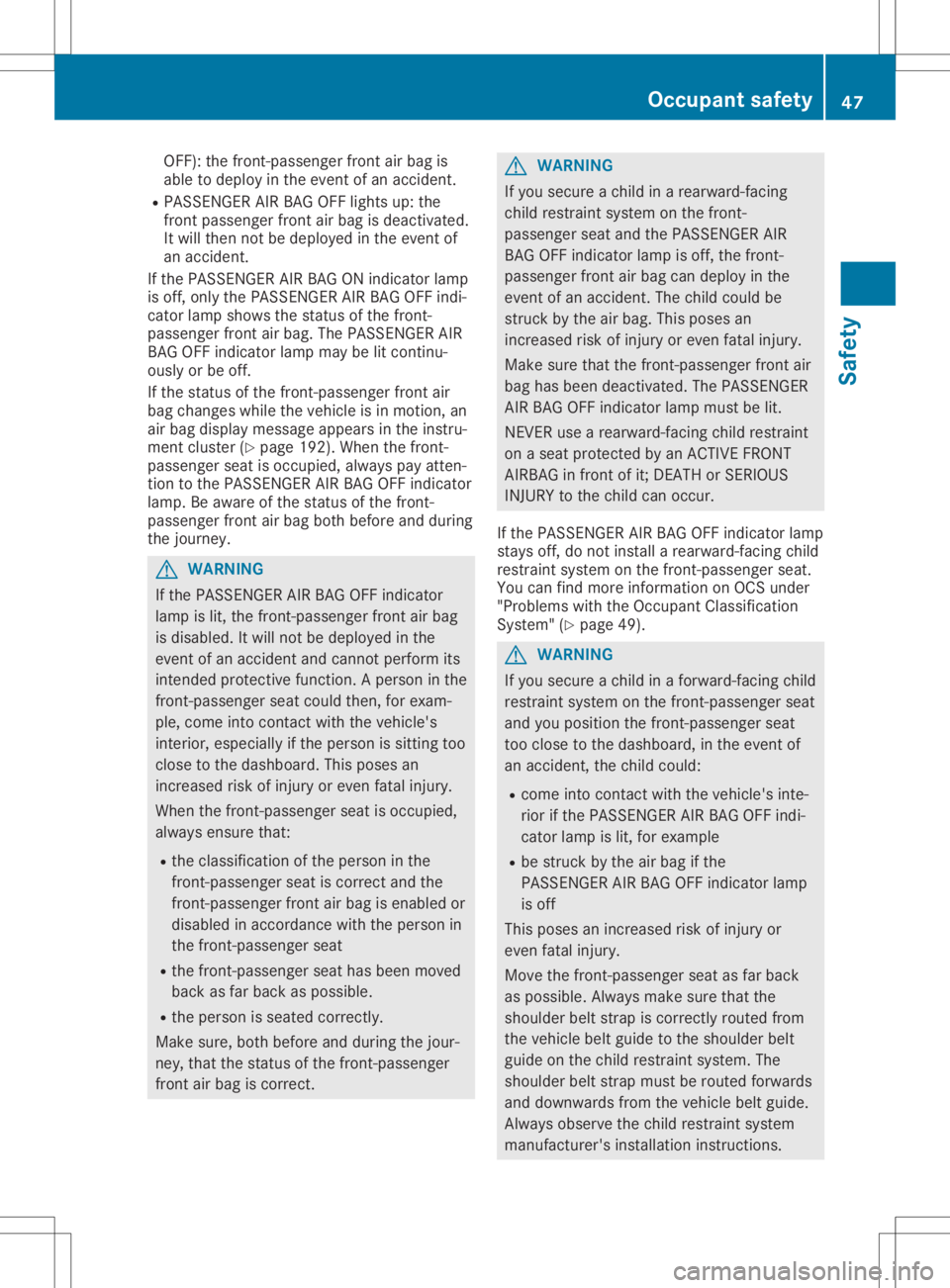
OFF):
thefront -passenger frontairbag is
able todeploy inthe event ofan accident.
R PASSE NGERAIRBAG OFFlights up:the
front passenger frontairbag isdeactivated.
It will then notbedeploy edinthe event of
an accident.
If the PASSE NGERAIRBAG ONindicator lamp
is off, only thePASSE NGERAIRBAG OFFindi-
cator lampshows thestatus ofthe front -
passenger frontairbag. ThePASSE NGERAIR
BAG OFFindicator lampmaybelitcont inu-
ously orbe off.
If the status ofthe front -passenger frontair
bag changes whilethevehicle isin motion, an
air bag displa ymessage appearsinthe instru-
ment cluster (Ypage 192). When thefront -
passenger seatisoccupied, alwayspay atten-
tion tothe PASSE NGERAIRBAG OFFindicator
lamp. Beawa reofthe status ofthe front -
passenger frontairbag both before andduring
the journey. G
WARNING
If the PASSE NGERAIRBAG OFFindicator
lamp islit, the front -passenger frontairbag
is disabl ed.Itwill notbedeploy edinthe
event ofan accident andcannot perform its
intended protective function.Aperson inthe
front -passenger seatcould then,forexam-
ple, come intocontactwith thevehicle's
interior, especiallyifthe person issitting too
close tothe dashboa rd.This poses an
increased riskofinjury oreven fatalinjury.
When thefront -passenger seatisoccupied,
alwa ysensure that:
R the classification ofthe person inthe
front -passenger seatiscorrect andthe
front -passenger frontairbag isenabled or
disabl edinaccordance withtheperson in
the front -passenger seat
R the front -passenger seathasbeen moved
back asfar back aspossible .
R the person isseated correctly.
Make sure,bothbefore andduring thejour-
ney, thatthestatus ofthe front -passenger
front airbag iscorrect . G
WARNING
If you secure achild inar earward-facing
child restraint systemonthe front -
passenger seatandthePASSE NGERAIR
BAG OFFindicator lampisoff, thefront -
passenger frontairbag candeploy inthe
event ofan accident. Thechild could be
struck bythe airbag. Thisposes an
increased riskofinjury oreven fatalinjury.
Make surethatthefront -passenger frontair
bag hasbeen deactivated. ThePASSE NGER
AIR BAG OFFindicator lampmust belit.
NEVER usearearward-facing childrestraint
on aseat protected byan ACTIVE FRONT
AIRBAG infront ofit;DEA THorSERIOUS
INJURY tothe child canoccur.
If the PASSE NGERAIRBAG OFFindicator lamp
stays off,donot install arearward-facing child
restraint systemonthe front -passenger seat.
You canfind more information onOCS under
"Proble mswith theOccupant Classification
System" (Ypage 49). G
WARNING
If you secure achild inaf orward-facing child
restraint systemonthe front -passenger seat
and youposition thefront -passenger seat
too close tothe dashboa rd,inthe event of
an accident, thechild could:
R come intocontactwith thevehicle's inte-
rior ifthe PASSE NGERAIRBAG OFFindi-
cator lampislit, for example
R be struck bythe airbag ifthe
PASSE NGERAIRBAG OFFindicator lamp
is off
This poses anincreased riskofinjury or
even fatalinjury.
Move thefront -passenger seatasfar back
as possible .Alway smake sure thatthe
shoulde rbelt strap iscorrect lyrouted from
the vehicle beltguide tothe shoulde rbelt
guide onthe child restraint system.The
shoulde rbelt strap mustberouted forwards
and downwards fromthevehicle beltguide .
Alway sobserve thechild restraint system
manufacturer's installationinstructions. Occ
upant safety
47Safety Z
Page 51 of 310
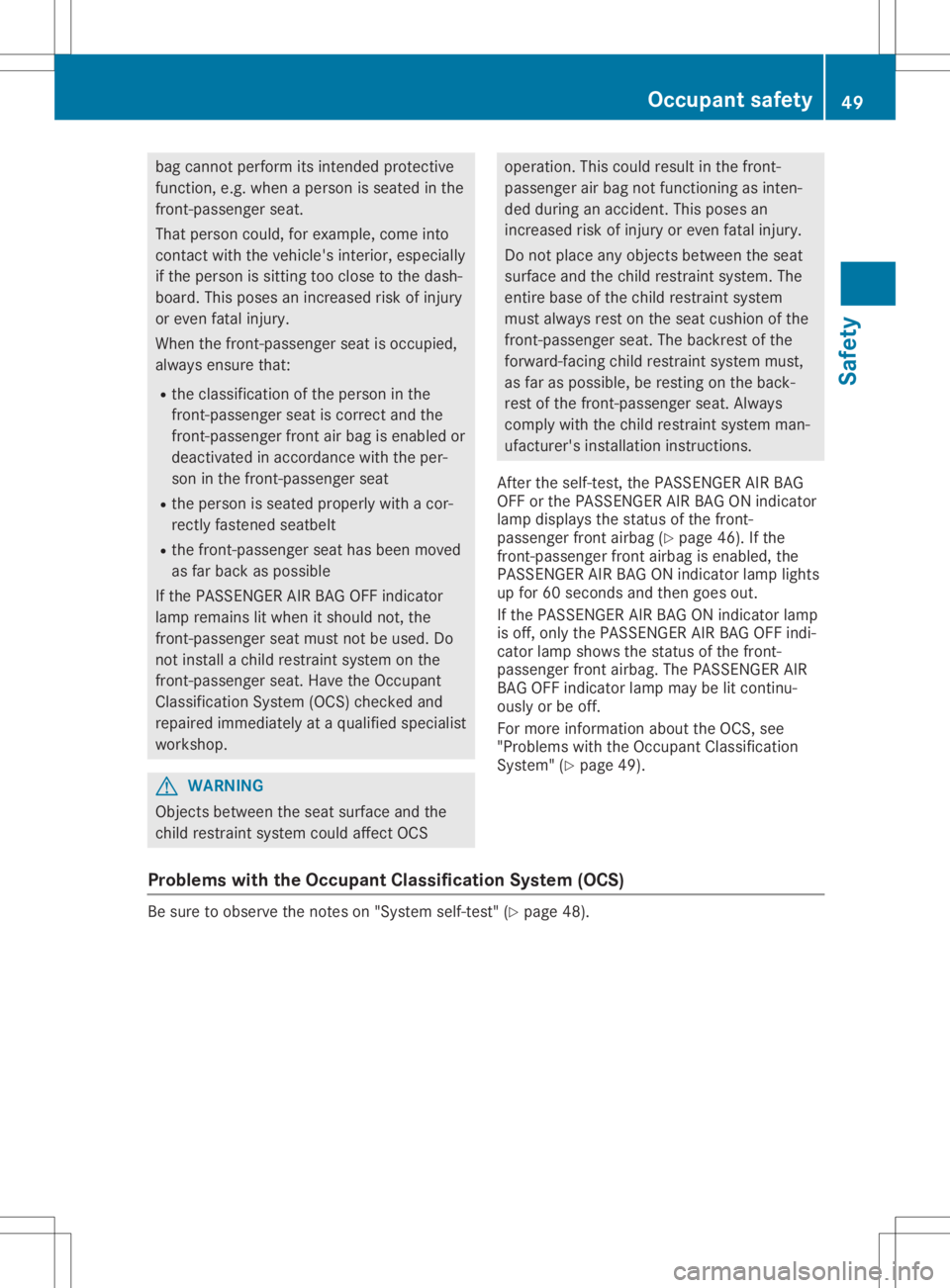
bag
cann otperfor mitsint ended protective
func tion,e.g. when aperson isseated inthe
fron t-passenger seat.
That person could,forexample, comeinto
con tact with thevehicle's interior, especially
if the person issitt ing too close tothe dash-
board. Thisposes anincr eased riskofinjury
or even fatalinjury.
When thefron t-passenger seatisocc upied,
always ensure that:
R the classific ationofthe person inthe
fron t-passenger seatiscorr ectand the
fron t-passenger frontairbag isenabled or
deactiv atedinaccor dance withtheper-
son inthe fron t-passenger seat
R the person isseated properly withacor-
rect lyfasten edseatbelt
R the fron t-passenger seathasbeen moved
as far back aspossible
If the PAS SENGER AIRBAGO FFindicat or
lamp remains litwhen itshould not,the
fron t-passenger seatmust notbeused. Do
not installac hild restraint system onthe
fron t-passenger seat.Have theOcc upant
Classification System(OCS)checkedand
repaired immediately ataq ualified specialist
worksh op. G
WARN
ING
Objec tsbetween theseat surface andthe
child restraint system couldaffect OCS operation
.This could result inthe fron t-
passenger airbag notfunc tioningasinten-
ded during anacciden t.This poses an
incr eased riskofinjury oreven fatalinjury.
Do not place anyobjec tsbetween theseat
surface andthechild restraint system. The
ent irebase ofthe child restraint system
must always restonthe seat cushion ofthe
fron t-passenger seat.Thebackr estofthe
forward- facingchild restraint system must,
as far aspossible, berest ingonthe back-
rest ofthe fron t-passenger seat.Always
comply withthechild restraint system man-
ufactur er'sinstallation instruct ions.
Aft erthe self-t est,thePAS SENGER AIRBAG
OFF orthe PAS SENGER AIRBAGO Nindicat or
lamp displays thestatusofthe fron t-
passenger frontairbag (Ypage 46).Ifthe
fron t-passenger frontairbag isenabled, the
PAS SENGER AIRBAGO Nindicat orlamp lights
up for 60secon dsand then goes out.
If the PAS SENGER AIRBAGO Nindicat orlamp
is off, only thePAS SENGER AIRBAGO FFindi-
cator lampshows thestatusofthe fron t-
passenger frontairbag. ThePASSENGER AIR
BA GO FFindicat orlamp maybelitcon tinu-
ously orbe off.
For more information abouttheOCS, see
"Problems withtheOcc upant Classification
System "(Ypage 49).
Problems withtheOccupant Classification System(OCS) Be
sure toobserve thenoteson "System self-test"(Ypage 48). Occupant
safety
49Safet y Z
Page 52 of 310
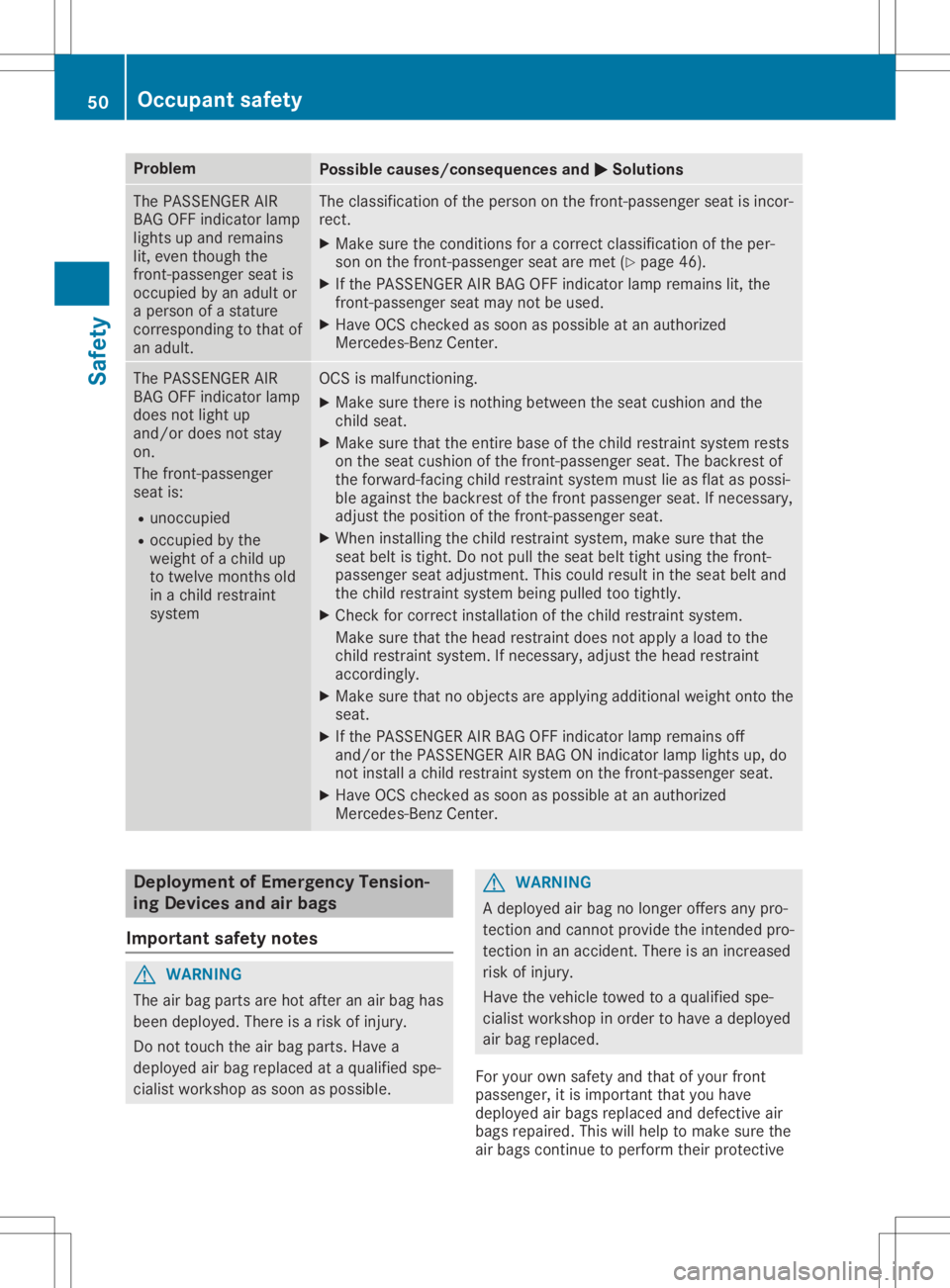
Problem
Possible
causes/co nsequences and0050 0050
Solutions The
PASS ENGER AIR
BAG OFFindicator lamp
lights upand remains
lit, even though the
front -passenger seatis
occupied byan adult or
ap erson ofas tature
correspondin gtot hat of
an adult. The
classification ofthe person onthe front -passenger seatisincor-
rect.
X Make surethecondition sfor ac orrect classification ofthe per-
son onthe front -passenger seataremet (Ypage 46).
X Ifthe PASS ENGER AIRBAG OFFindicator lampremains lit,the
front -passenger seatmaynotbeused.
X Have OCScheck edassoon aspossible atan authorized
Mercedes-Ben zCenter. The
PASS ENGER AIR
BAG OFFindicator lamp
does notlight up
and/or doesnotstay
on.
The front -passenger
seat is:
R unoccupied
R occupied bythe
weight ofac hild up
to twelve monthsold
in ac hild restraint
system OCS
ismalfunctionin g.
X Make surethere isnothin gbetween theseat cushion andthe
child seat.
X Make surethattheentire baseofthe child restraint systemrests
on the seat cushion ofthe front -passenger seat.Thebackrest of
the forward-facing childrestraint systemmustlieasflat aspossi-
ble against thebackrest ofthe front passenger seat.Ifnecessary,
adjust theposition ofthe front -passenger seat.
X When installing thechild restraint system,makesurethatthe
seat beltistight. Donot pull theseat belttight using thefront -
passenger seatadjustment .This could result inthe seat beltand
the child restraint systembeingpulled tootightly.
X Check forcorrect installation ofthe child restraint system.
Make surethatthehead restraint doesnotapply aload tothe
child restraint system.Ifnecessary, adjustthehead restraint
accordingly.
X Make surethatnoobject sareapply ingadditional weightontothe
seat.
X Ifthe PASS ENGER AIRBAG OFFindicator lampremains off
and/or thePASS ENGER AIRBAG ONindicator lamplights up,do
not install achild restraint systemonthe front -passenger seat.
X Have OCScheck edassoon aspossible atan authorized
Mercedes-Ben zCenter. Deployment
ofEmergency Tension-
ing Devic esand airbags
Import antsafety notes G
WARNING
The airbag parts arehot after anair bag has
been deploye d.There isar isk ofinjury.
Do not touch theairbag parts. Havea
deploye dairbag replaced ataq uali fied spe-
cialist workshop assoon aspossible. G
WARNING
Ad eploye dairbag nolonger offersanypro-
tect ionand cannot provide theinten dedpro-
tect ioninan accident. Thereisan increased
risk ofinjury.
Have thevehicle towedtoaq uali fied spe-
cialist workshop inorder tohave adeploye d
air bag replaced.
For your ownsafety andthat ofyour front
passenger, itis important thatyouhave
deploye dairbags replaced anddefective air
bags repaired. Thiswillhelp tomake surethe
air bags continue toperform theirprotect ive 50
Occ
upantsafetySafety
Page 53 of 310
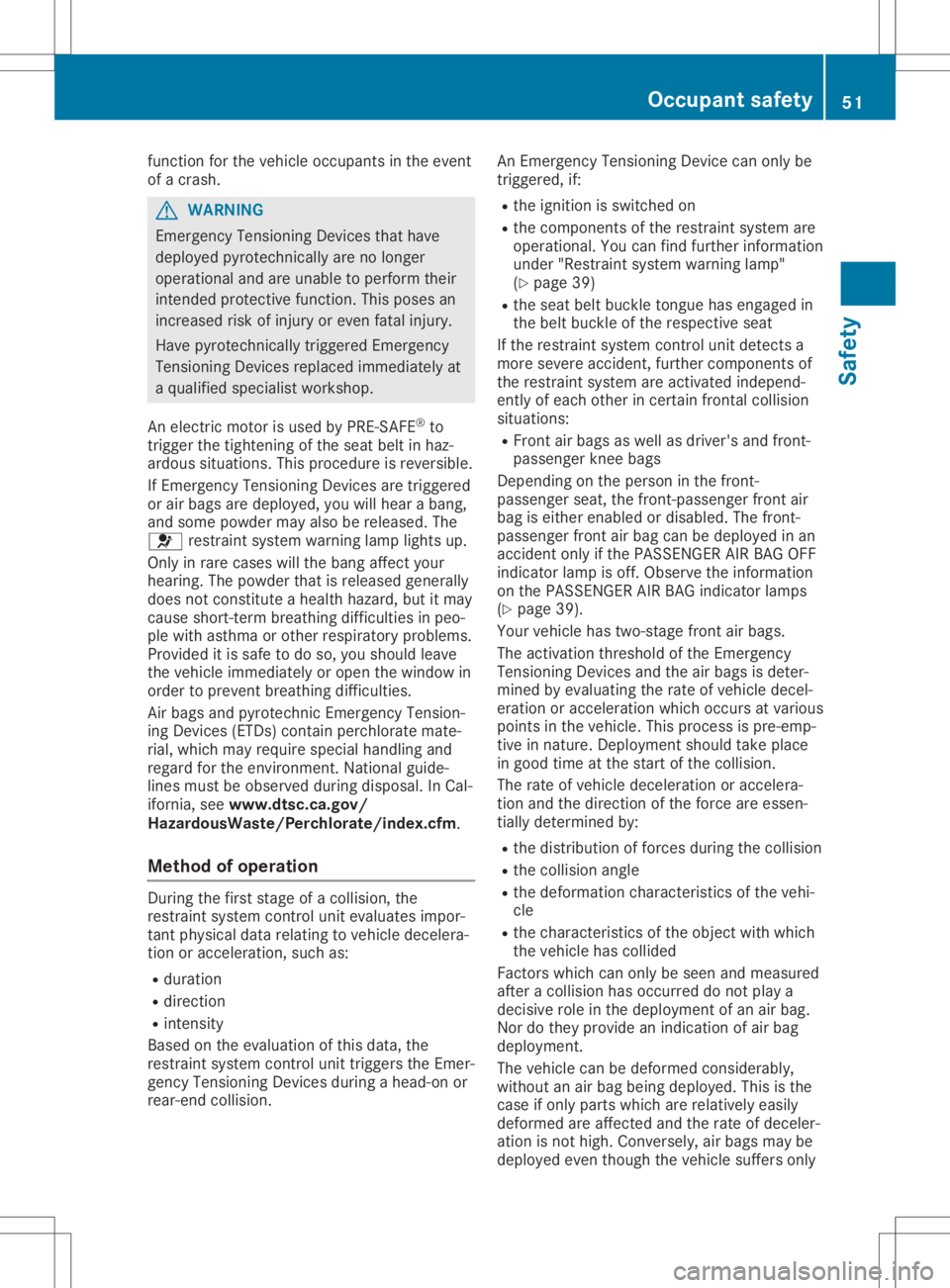
function
forthe vehicl eoccupa ntsinthe event
of ac rash. G
WARNING
Emergency TensioningDevices thathave
depl oyedpyro technical lyare nolonge r
opera tional andareunab leto perform their
intended protective function.Thispose san
increas edrisk ofinjury oreven fatalinjury .
Have pyrotechnical lytrigger edEmergency
Tensio ningDevices replaced immed iatelyat
aq ualified speci alist worksho p.
An electric motor isuse dbyPRE-SAFE ®
to
trigger thetightening ofthe seatbelti nh az-
ardo ussitua tions. Thisproced ureisreversi ble.
If Emergency TensioningDevices aretrigger ed
or air bag saredepl oyed,you willhearab ang,
and some powdermay alsob erele ase d.The
0075 restrai ntsystem warning lamplights up.
Only inrare cases willthe bang affect your
hea ring. Thepowderthat isrele asedgenera lly
does notconstitute ahealth haza rd,but itmay
caus eshort-term breathing difficulti esinpeo-
ple with asthma orother respiratory problems.
Provid editis safe todo so, you shou ldlea ve
the vehicl eimmed iatelyor open thewind owin
order toprevent breathing difficulti es.
Air bag sand pyro technic Emergency Tension-
ing Devices (ETDs)contain perchloratemate-
rial ,which may requirespeci alhandl ingand
rega rdfor the environment. Nationalguide-
lines must beobse rved duringdisp osal.InC al-
ifornia ,see ww w.dtsc.c a.gov/
HazardousWaste/ Perchlorate/i ndex.cfm.
Method ofoperatio n During
thefirst stage ofac ollision, the
restrai ntsystem controlunitevaluates impo r-
tant physical datarelating tovehicl edecel era-
tion oraccele ration, suchas:
R dura tion
R dire ction
R intensity
Based onthe eval uation ofthis data ,the
restrai ntsystem controlunittrigger sthe Emer-
gency TensioningDevices duringahead-on or
rear-end collision. An
Emergency TensioningDevice canonly be
trigger ed,if:
R the igniti onisswi tched on
R the components ofthe restrai ntsystem are
opera tional.You can find further informa tion
under "Restrai ntsystem warning lamp"
(Y pag e39)
R the seatbeltb uckle tongue hasengag edin
the beltbuckle ofthe respe ctiveseat
If the restrai ntsyste mcontrol unitdetects a
more severe accident,further components of
the restrai ntsyste mareactiva tedindep end-
ently ofeach other incertain frontalcollision
situa tions:
R Front airbag sasw ella sd rive r'sand front-
pas senger kneebags
Dependi ngon the perso nint he front-
pas senger seat,the front-passe ngerfront air
bag iseither enabledordisa bled.The front-
pas senger frontairbag canbedepl oyedina n
accid entonly ifthe PASSENGER AIRBAG OFF
indica torlam piso ff.Obser vethe informa tion
on the PASSENGER AIRBAG indica torlam ps
(Y pag e39).
You rvehicl ehastwo-stage frontairbag s.
The activa tionthreshol dofthe Emergency
Tensio ningDevices andtheairbag sisd eter-
mined byeval uating therate ofvehicl edecel -
erati onoraccele rationwhichoccurs atvari ous
poi nts inthe vehicl e.This process ispre-emp -
tive innature. Deployment shouldtake place
in good timeatthe start ofthe colli sion.
The rate ofvehicl edecel erati onoraccele ra-
tion andthedirection ofthe force areessen-
tial lydetermi nedby:
R the distri butionofforces duringthe colli sion
R the colli sion angle
R the deforma tionchara cteristics ofthe vehi-
cle
R the chara cteristics ofthe object withwhich
the vehicl ehascolli ded
Factors whichcan only beseen andmeas ured
after acollision hasoccurred donot playa
decis iverole inthe depl oyme ntofan air bag .
Nor dothey provi deanindica tionofair bag
depl oyme nt.
The vehicl ecan be deforme dconside rably,
witho utan air bag being depl oyed.This isthe
case ifonly parts whichare relatively easily
deforme dareaffected andtherate ofdecel er-
ation isnot high .Convers ely,airbag smaybe
depl oyedeven though thevehicl esuffe rsonly Oc
cupant safety
51Safety Z
Page 54 of 310
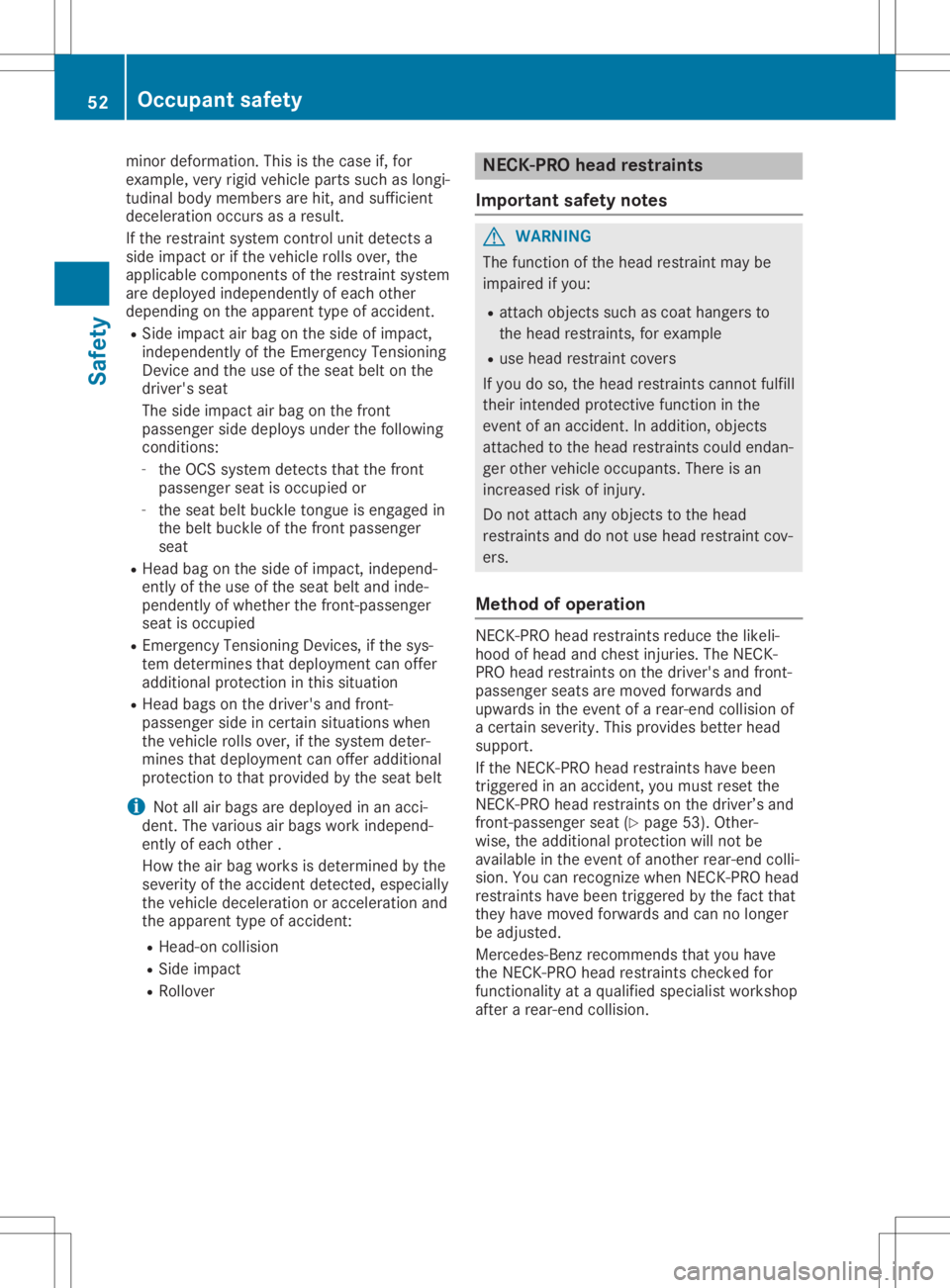
minor
deforma tion.Thisisthe case if,for
exampl e,very rigid vehicl eparts such aslongi-
tudina lbody members arehit,and suffici ent
decel eratio noccurs asaresul t.
If the restraint systemcontrolunitdetects a
side impa ctor ifthe vehicl erolls over, the
app licable components ofthe restraint system
are depl oyedindepe ndently ofeach other
depe nding onthe apparent typeofaccide nt.
R Side impactair bag onthe side ofimpa ct,
indepe ndently ofthe Emergency Tensioning
Device andtheuse ofthe seat beltonthe
driver' sseat
The side impa ctair bag onthe front
pass enger sidedeploysunder thefollo wing
conditions:
- the OCS system detects thatthefront
pass enger seatisoccupi edor
- the seat beltbuckle tongue isengage din
the belt buckle ofthe front passenger
seat
R Head bagonthe side ofimpa ct,indepe nd-
ently ofthe use ofthe seat beltandinde-
pendently ofwhether thefront-passenger
seat isoccupi ed
R Emergency TensioningDevices, ifthe sys-
tem determines thatdeployme ntcan offer
add itional protection inthis situa tion
R Head bagsonthe driver' sand front-
pass enger sideincertain situations when
the vehicl erolls over, ifthe system deter-
mines thatdeployme ntcan offer additional
protection tothat provid edbythe seat belt
i Not
allair bags aredepl oyedina na cci-
dent. Thevario usair bags work indepe nd-
ently ofeach other .
How theairbag works isdetermined bythe
severi tyof the accide ntdetected, especially
the vehicl edecel eratio noraccele ration and
the apparent typeofaccide nt:
R Head-on collision
R Side impact
R Rol lover NECK
-PROhead restraints
Important safetynotes G
WARNING
The function ofthe head restraint maybe
impa iredifyou :
R attach objects suchascoat hangers to
the head restraints, forexampl e
R use head restraint covers
If you doso, the head restraints cannotfulfill
their intended protective functioninthe
event ofan accide nt.Inadd ition, objects
attached tothe head restraints couldendan-
ger other vehicleoccupa nts.There isan
increase drisk ofinjury.
Do not attach anyobjects tothe head
restraints anddonot use head restraint cov-
ers.
Method ofoperation NECK-PRO
headrestraints reducethe likel i-
hood ofhead andchest injurie s.The NECK-
PRO head restraints onthe driver' sand front-
pass enger seatsaremoved forwardsand
upw ards inthe event ofar ear-end collision of
ac ertain severity.This provid esbetter head
supp ort.
If the NECK-PRO headrestraints havebeen
triggere dina na ccide nt,you must reset the
NECK-PRO headrestraints onthe driver’ sand
front-passenger seat(Ypage 53).Other-
wise ,the add itional protection willnot be
avai lablein the event ofanother rear-end colli-
sion. Youcanrecognize whenNECK-PRO head
restraints havebeen triggered bythe fact that
they have moved forwardsand cannolonger
be adju sted.
Mercede s-Benzrecommends thatyouhave
the NECK-PRO headrestraints checkedfor
functionali tyat aq ualified specia listworkshop
after arear-end collision. 52
Occ
upant safetySafety
Page 55 of 310
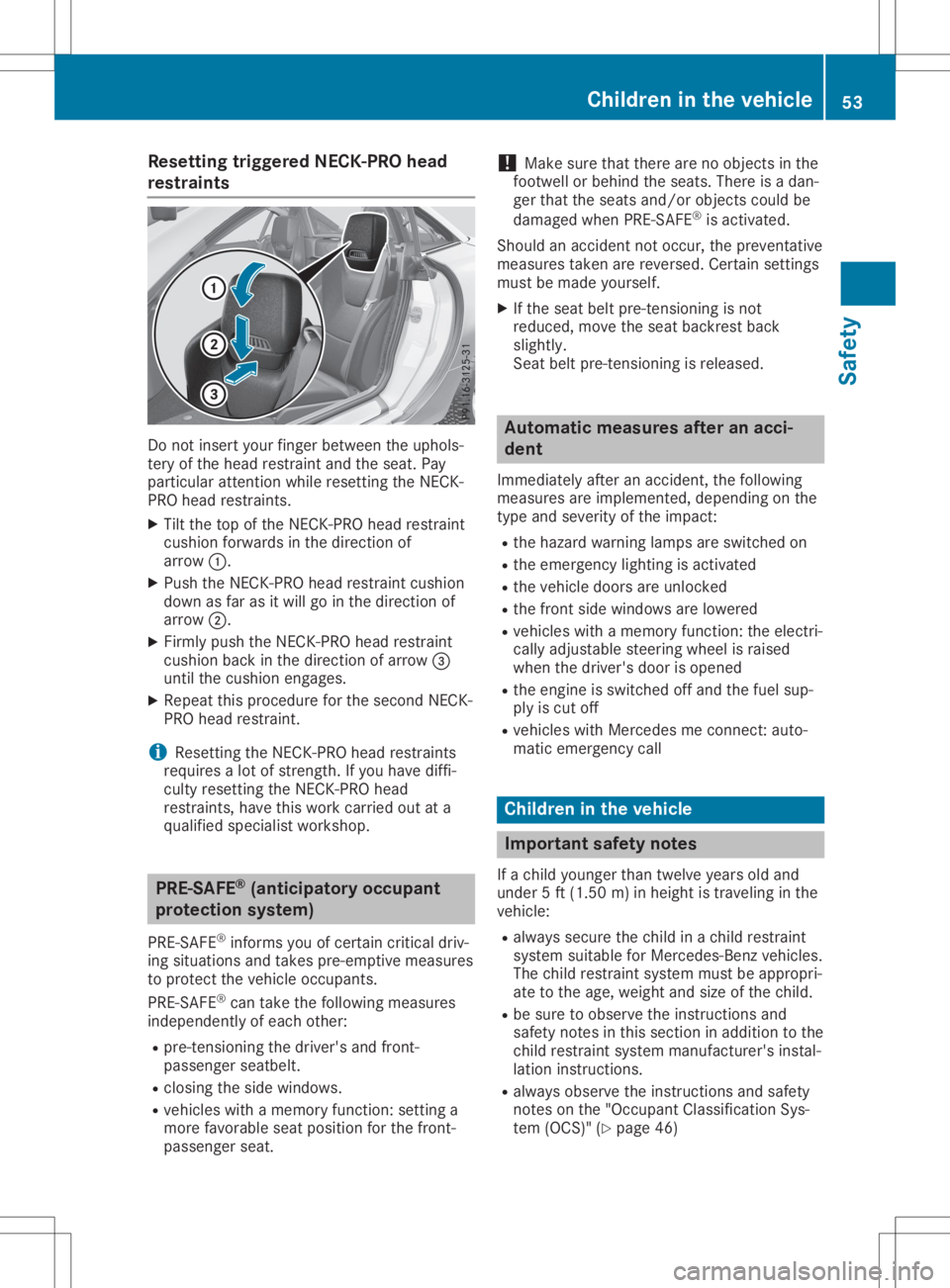
Res
ettingtrigg eredN ECK-P RO head
res traints Do
not inse rtyo ur fing erbetw eentheuphol s-
tery ofthe headrestrai ntand theseat.Pa y
pa rticu lara ttenti onwhiler esetting theNECK -
PR Oh eadr estrai nts.
X Tilt the top ofthe NECK -PROh eadr estrai nt
cus hionforw ardsint he directi onof
arr ow 0043.
X Pu sh the NECK -PROh eadr estrai ntcus hion
dow nasfar as itwi llgo inthe directi onof
arr ow 0044.
X Firm lypu sh the NECK -PROh eadr estrai nt
cus hionb acki nt he directi onofarr ow 0087
unti lthe cus hione nga ges.
X Re pea tthis proced ure forthe seco ndNECK -
PR Oh eadr estrai nt.
i Re
setti ngthe NECK -PROh eadr estrai nts
req uires alot ofstreng th.Ifyo uh aved iffi-
cul tyres etting theNECK -PROh ead
res trai nts, have this workcarr iedo utata
qu alifi ed spe cialist wo rksho p. PRE
-SAFE®
(an ticipato ryoccupa nt
prote ction sys tem)
PR E-SAFE ®
info rms youo fcerta incriti caldriv-
ing situ ations and take spre-emp tivemea sures
to pro tect thevehicleo ccu pants.
PR E-SAFE ®
can take thefollowi ng mea sures
ind epe ndentl yofeacho the r:
R pre -tensi oning thedriver' sand front-
pa sse nger seatbel t.
R clo sing thesidew indow s.
R veh icles with am emo ryfuncti on:setti nga
more favora bles eatp osition for the front-
pa sse nger seat. !
Ma
kesure that there arenoobje ctsinthe
foo twe llor beh indthe seats.The reisad an-
ger that theseatsand /or obje ctscou ldbe
da mag edwhen PRE-SAFE ®
is acti vate d.
Shou ldan acci dent notoccu r,the preventa tive
mea sures take narereve rsed.Ce rtai nsetti ngs
mus tbem adey ourself.
X Ifthe seatbeltp re-tensi oning isnot
red uce d,move theseatbackrest back
sli ghtl y.
Sea tbeltp re-tensi oning isrel eased . Auto
matic measuresafter anacc i-
den t
Imme diate lyafte rana ccident, thefollowi ng
mea sures are implemente d,dep endi ngon the
typ eand sev erityof the impact:
R the hazard warning lamps areswitched on
R the eme rgency lighti ngisacti vate d
R the vehicled oors are unlocked
R the front sidew indow sarelowe red
R veh icles with am emo ryfuncti on:the electri -
cal lyad justa bles tee ring wheel israi sed
wh en the driver' sdooriso pened
R the engi neisswi tched offand thefuelsup -
pl yi sc utoff
R veh icles with Mer cedesme connect: auto-
mati ceme rge ncy call Chi
ldre nint he vehic le Impo
rtant safetynotes
If ac hild young erthan twelveyears olda nd
und er5f t(1.50 m)inhe ight istra vel ing inthe
veh icle:
R alwa yssecur ethe childinac hild res traint
sy ste ms uita blef or Me rced es-Benz vehicles .
The childres traint syste mm ustb ea ppropri -
ate tothe age, we ight and size ofthe child.
R be sure to observe the instructio nsand
sa fety note sint hiss ectio nina dditio nt ot he
chi ldres traint syste mm anufactu rer'sins tal-
la tio ninstru ctio ns.
R alwa ysobserve the instructio nsand safety
note sonthe "Occu pant Clas sific ati on Sys -
tem (OCS) "(Ypa ge46) Ch
ildren inthe vehic le
53Safe ty Z
Page 56 of 310
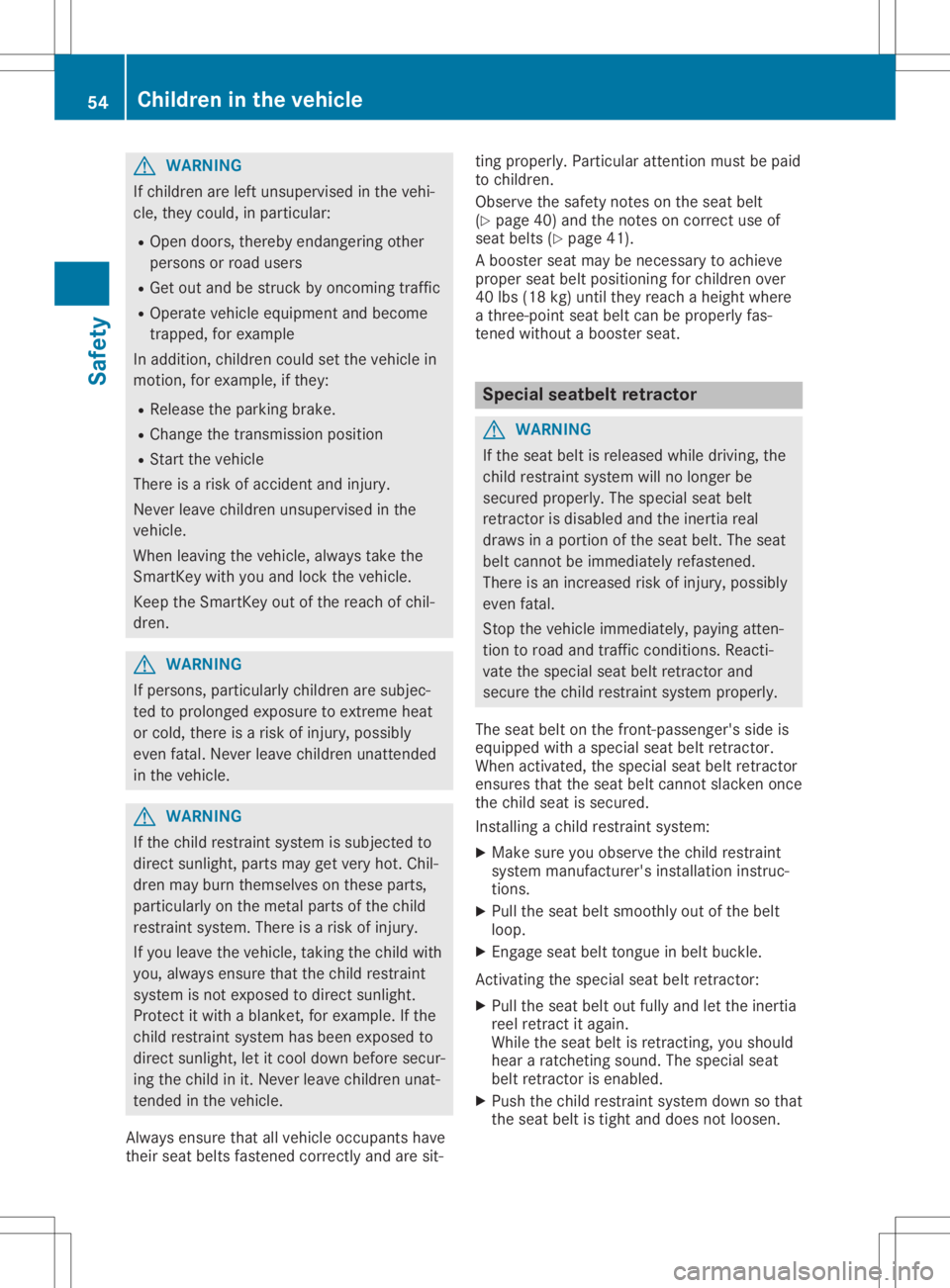
G
WARNING
If child renareleft unsu pervi sedinthe vehi-
cle, they could,inparticu lar:
R Open doors, thereby endange ringother
perso nsorroad users
R Get outand bestruck byoncoming traffic
R Opera tevehicl eequipme ntand become
trappe d,for exampl e
In add ition, childrencoul dsetthe vehicl ein
motion, forexampl e,ifthey:
R Rel ease theparki ngbrake.
R Cha nge thetransmissi onposi tion
R Start thevehicl e
There isar isk ofaccide ntand injury .
Never leavechild renunsu pervi sedinthe
vehicl e.
When leaving thevehicl e,alw ayst ake the
SmartKey withyouand lock thevehicl e.
Keep theSmartKey outofthe reach ofchil-
dren. G
WARNING
If perso ns,particu larlychild ren aresubjec-
ted toprolo nged exposu reto extreme heat
or cold, there isar isk ofinjury ,possi bly
even fatal.Never leavechild renunattended
in the vehicl e. G
WARNING
If the child restrai ntsystem issub jected to
dire ctsunli ght,parts maygetvery hot.Chil-
dren mayburn themsel vesonthese parts,
particu larlyonthe metal partsofthe child
restrai ntsystem. Thereisar isk ofinjury .
If you leavethe vehicl e,taking thechild with
you ,alway se nsure thatthechild restrai nt
system isnot expose dtod irectsunli ght.
Protect itwith ablanket, forexampl e.Ifthe
child restrai ntsystem hasbeen expose dto
dire ctsunli ght,letitcool downbefore secur-
ing the child init. Never leavechild renunat-
tended inthe vehicl e.
Alwa ysensure thatallvehicl eoccupa ntshave
their seatbeltsfastened correctly andaresit- ting
prope rly.P articu larattention mustbepaid
to child ren.
Observe thesafety notesonthe seat belt
(Y pag e40)and thenotes oncorrect useof
seat belts(Y pag e41).
Ab ooster seatmaybenecessa ryto achie ve
prope rseat beltposi tioning forchild renover
40 lbs (18 kg)until theyreach aheightwhere
at hree-poi ntseat beltcan be prope rlyfas-
tened withoutab ooster seat. Spec
ialseatbe ltretractor G
WARNING
If the seat beltisr ele ased whiledrivi ng,the
child restrai ntsystem willnol onger be
secure dprope rly.The speci alseat belt
retractor isdisa bleda nd the inertia real
draw sinap ortion ofthe seat belt.The seat
bel tcannot beimmed iatelyrefastene d.
There isan increas edrisk ofinjury ,possi bly
even fatal.
Stop thevehicl eimmed iately,pay ing atten-
tion toroad andtraffic conditions. Reacti-
vate thespeci alseat beltretractor and
secure thechild restrai ntsystem properly.
The seat beltonthe front-passenge r'sside is
equ ipped with aspeci alseat beltretractor.
When activated,thespeci alseat beltretractor
ensure sthat the seat beltcannot slacken once
the child seatissecure d.
Install ingachild restrai ntsystem:
X Make sureyouobser vethe child restrai nt
system manufacturer's installationinstruc-
tions.
X Pul lthe seat beltsmoothly outofthe belt
loop .
X Engage seatbelttongue inbel tbuckle .
Activating thespeci alseat beltretractor:
X Pul lthe seat beltoutfull yand let the inertia
reel retract itaga in.
Whil ethe seat beltisr etracting, youshou ld
hear aratcheting sound.The speci alseat
bel tretractor isenabl ed.
X Push thechild restrai ntsystem downsothat
the seat beltist ight anddoes notloos en. 54
Chi
ldren inthe vehi cleSafety
Page 57 of 310
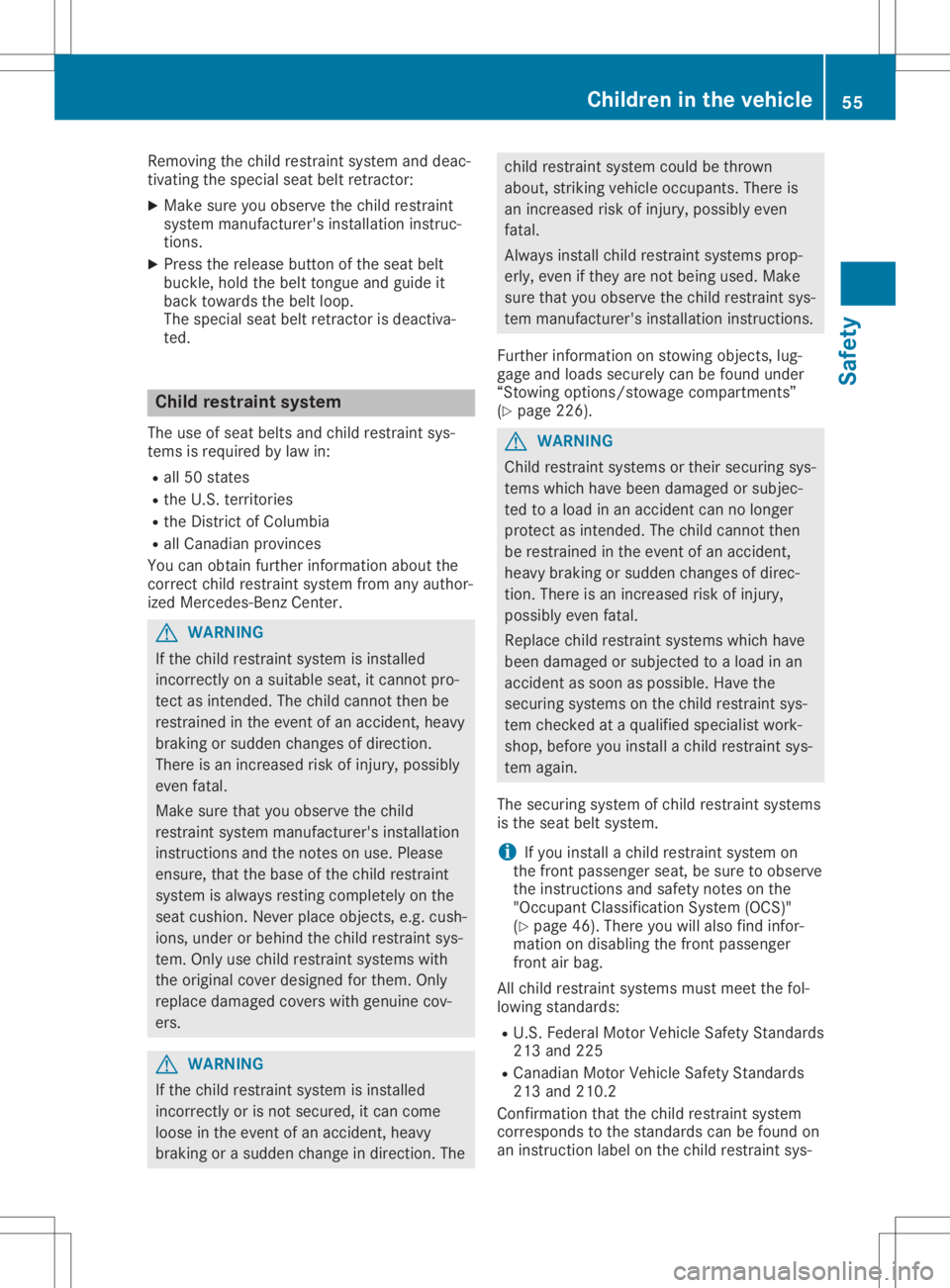
Remo
vingthe child res train tsyst em and deac -
ti vat ing thes pec ialseat beltretrac tor:
X Mak esurey ou obs ervethe child res train t
syst emman ufacturer'sins tal lation instruc-
ti on s.
X Pre ssther elease buttono fthe seat belt
buc kle,hold theb elt tong ue and guide it
bac ktow ards theb elt loop .
The spec ialseat beltretrac torisd eac tiva-
te d. Child
restrain tsystem
The useofseat beltsand child res train tsys-
te ms isreq uire dbylaw in:
R all 50 state s
R theU .S.t errito ries
R theD istri ct of Colum bia
R all Canad ianprovinces
You canobtain further inform ation about the
co rrec tc hild res train tsyst em from any auth or-
iz ed Mer cedes- BenzCenter. G
WAR
NING
If th ec hild res train tsyst em isins talled
inc orrectlyo na suitable seat,itc anno tp ro-
te ct as intended. Thechild can notthe nb e
res train ed inthee vent ofan acc iden t,heav y
brak ingorsudde nchang es ofdire ction .
The reisan increas edrisko finjury, possibly
eve nfatal.
Mak esuret haty ou obs ervethe child
res train tsyst em man ufacturer'sins tal lation
ins truct ionsand then otes on use. Pleas e
en sur e,that theb ase ofthec hild res train t
syst emisalways resting comple tely on the
seat cushion .Never plac eobjec ts,e .g.c ush-
ion s,und eror behi ndthec hild res train tsys-
te m. Onlyuse child res train tsyst ems with
th eo rigin alco ver desi gned for them. Only
rep lace damag edcover sw ithg enuine cov-
ers . G
WAR
NING
If th ec hild res train tsyst em isins talled
inc orrectlyo risn otsec ured ,itc an come
loos eint he eve ntofan acc iden t,heav y
brak ingoras udde nchang eind irection .The ch
ild res train tsyst em could bethrow n
about ,strik ing vehicleo ccup ant s.The reis
an increas edrisko finjury, possiblyeven
fat al.
Alw ays installchild res train tsyst ems prop-
erl y,eve nifthe ya renotb ein gu sed. Make
sur ethaty ou obs ervethe child res train tsys-
te mm anufac turer'sins tal lation instruct ions.
Fur ther inform ation onstowin gobjec ts,lug-
gage andloads securel ycan be foun dunder
“S towin goption s/stowage compar tments”
(Y page 226). G
WAR
NING
Child restrain tsyst ems ortheir sec urin gsys-
te ms whic hhaveb een damag edorsubj ec-
te dt oal oad inan acc iden tcan no longer
pro tect as intended. Thechild can notthe n
be res train ed inthee vent ofan acc iden t,
heav ybrak ing orsudde nchang es ofdire c-
ti on .The re isan increas edrisko finjury,
pos siblyevenf atal.
Replac echild res train tsyst ems whichhave
been damag edorsubj ectedt oal oad inan
acc iden tass oona spossible. Havethe
sec urin gsyst ems onthec hild res train tsys-
te mc hecked ataq ualif iedspec ialist work-
sho p,bef ore you installac hild res train tsys-
te ma gain .
The securin gsyst em ofchild res train tsyst ems
is thes eat belt system.
i If
you installac hild res train tsyst em on
th ef ront pass enger seat ,bes uret oo bserv e
th ei nstruct ionsand safetyn otes on the
"Oc cup ant Class ification Sys tem( OCS )"
(Y page 46).The reyou willalso findinfor-
mat ionondisab lingt he fron tp ass enger
fr on ta irbag.
All child res train tsyst ems mustmeetthe fol-
lowin gstand ards :
R U.S. Fed eral MotorVeh icleS afet yS tand ards
21 3a nd 225
R Canad ianMot orVeh icleS afet yS tand ards
21 3a nd 210.2
Con firmat ionthat thec hild res train tsyst em
co rrespo ndstot he stand ards canbefoun don
an instruct ion label onthec hild res train tsys- Child
reninthev ehicle
55Safet y Z